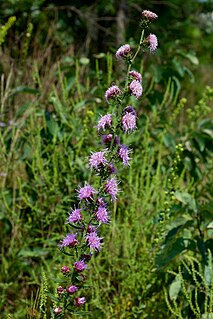
Lythrum salicaria or purple loosestrife is a flowering plant belonging to the family Lythraceae. It should not be confused with other plants sharing the name loosestrife that are members of the family Primulaceae. Other names include spiked loosestrife and purple Lythrum. This herbaceous perennial is native to Europe and Asia, and possibly Australia.

Liatris, commonly known as gayfeather, is a genus of flowering plants in the tribe Eupatorieae within the family Asteraceae native to North America. Its most common name is blazing star. Some species are used as ornamental plants, sometimes in flower bouquets.

Liatris aspera is a wildflower that is found in the mid to eastern United States in habitats that range from mesic to dry prairie and dry savanna.

Liatris pycnostachya, the prairie blazing star or cattail blazing star, is a perennial plant native to the tallgrass prairies of the central United States.

Liatris spicata, the dense blazing star or prairie feather, is an herbaceous perennial flowering plant in the family Asteraceae. It is native to eastern North America where it grows in moist prairies and sedge meadows.

Cirsium discolor, the field thistle, is a North American species of plants in the tribe Cardueae within the family Asteraceae. It is native to thirty-three states in the United States as well four Canadian provinces. It occurs across much of eastern and central Canada as well as eastern and central United States. It has been found from New Brunswick west to Saskatchewan and south as far as Texas and Georgia.
Liatris bracteata, commonly known as the bracted blazing star, or South Texas gayfeather, is a species of flowering plant in the family Asteraceae. It is native to Texas in the United States, where it is found in coastal prairies, roadsides, and along railroads with clay or sandy loam soils. This species is of conservation concern in its native range due to habitat loss.

Liatris chapmanii, also known as Chapman's blazing star or Chapman's gayfeather, is a plant species in the family Asteraceae and genus Liatris. It is native to Alabama, Florida and Georgia in the United States, where it is found in habitats such as dunes, beach strands, sand ridges, fields and roadsides, it also grows in longleaf pine savannas and other scrub habitats.
Liatris cokeri, also known as Coker's gayfeather and sandhills blazing star, is a plant species in the family Asteraceae and genus Liatris. It is native to North and South Carolina in the United States, where it is found in habitats such as sand ridges and sandy fields to roadsides; it is also found in turkey-oak and longleaf pine-oak plant communities. It blooms in late summer with purple flower heads.

Liatris cylindracea is a plant species in the family Asteraceae. It is native to eastern North America, where its populations are concentrated in the Midwestern United States. It is found in habitats such as prairies, limestone and sandstone outcroppings, bluffs, barrens, glades, woodlands and dunes.
Liatris cymosa, also known as Aggie-land gayfeather or branched blazing star, is a plant species in the family Asteraceae and genus Liatris. It is native to east central Texas in North America, where it is found in habitats such as post oak woodlands, fields, fence rows, woodland openings and edges, in clay soils. It blooms in mid to late summer with purple flower heads. It is of conservation concern due to habitat loss.

Liatris elegans, known commonly as pinkscale gayfeather, pinkscale blazingstar, and elegant blazingstar, is a species of flowering plant in the family Asteraceae. It is native to the southeastern United States as far west as Texas and Oklahoma.
Liatris oligocephala, the Cahaba torch, is a flowering plant in the genus Liatris. Its native range is very small, with all known populations being within Bibb County, Alabama, and therefore the species is of conservation concern. It hybridizes with the much more common Liatris cylindracea, but the offspring do not appear to cross with L. oligocephala.

Liatris helleri is a species of flowering plants in the family Asteraceae known by the common names Heller's blazing star and Heller's gayfeather. It is native to the Appalachian Mountains of the southeastern United States, found in the states of North Carolina, Virginia, West Virginia, and Maryland. It is threatened by recreational activities in its habitat, and is federally listed as a threatened species.

Liatris ohlingerae is a rare species of flowering plant in the family Asteraceae known by the common names Florida blazing star, Florida gayfeather, scrub blazing star, and sandtorch. It is endemic to Florida in the United States, where it occurs only on the Lake Wales Ridge along with many other rare plants. It is threatened by the loss and degradation of its habitat, and it is federally listed as an endangered species.

Liatris punctata is a species of flowering plant in the family Asteraceae known by the common names dotted gayfeather, dotted blazingstar, and narrow-leaved blazingstar. It is native to North America, where it occurs throughout the plains of central Canada, the central United States, and northern Mexico.

Liatris squarrosa, commonly called the scaly blazingstar, is an herbaceous perennial plant native to eastern and central North America, with most populations in the Southeastern United States. It is a somewhat conservative species, often found in dry or rocky areas of native prairie and savanna vegetation. It produces purple flowerheads in the summer.
Liatris lancifolia is a species of flowering plants in the family Asteraceae native to the prairies of central and western North America, known by the common names lanceleaf blazing star and Great Plains gayfeather.

Liatris ligulistylis is a flowering plant of the family Asteraceae, native to the central United States and central Canada.

Liatris hirsuta, commonly called hairy gayfeather, is a species of flowering plant in the family Asteraceae. It is native to North America, where it is found primarily in the Midwestern and South-Central regions of the United States. Its typical natural habitat is glades, rocky bluffs, and upland prairies.















